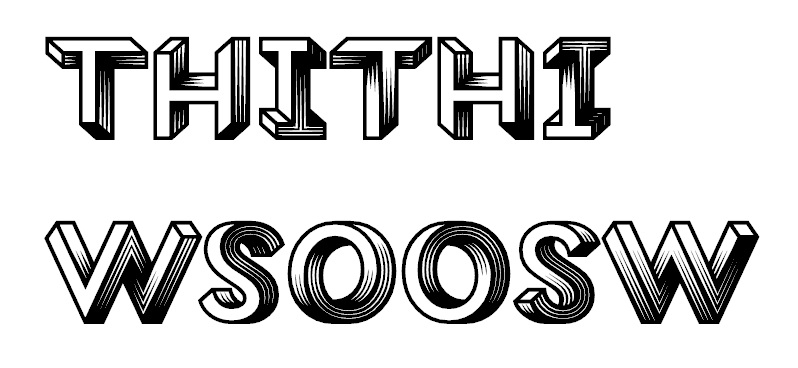Interesting OpenType Trick

Shahab Siavash
Posts: 141
I don't know you ever seen this font or this trick or not, but I've never seen this before in a Latin typeface.

All letters are uppercase in this picture and the glyphs change automatically. I mean, we have this for Persian typefaces. Isolated converts to initial and final becomes medial as you type, but I don't think I have seen this in a Latin typeface. (Because there is no initial, medial, final and isolated forms in Latin and uppercase letters are usually just come at the beginning of the sentences.) I think it is a very good effect especially when you type something like: "Success", "Beep", "Food", "Tall",...
You can try this yourself: https://www.boldmonday.com/typeface/macula/
P.S: Some of the designers have done this trick before, but not in an OpenType way, they would design different uppercase and lowercase letters and you have to type that manually.
Have you ever seen a typeface like this before? What do you think about the trick? I like the typeface, very much, btw.

All letters are uppercase in this picture and the glyphs change automatically. I mean, we have this for Persian typefaces. Isolated converts to initial and final becomes medial as you type, but I don't think I have seen this in a Latin typeface. (Because there is no initial, medial, final and isolated forms in Latin and uppercase letters are usually just come at the beginning of the sentences.) I think it is a very good effect especially when you type something like: "Success", "Beep", "Food", "Tall",...
You can try this yourself: https://www.boldmonday.com/typeface/macula/
P.S: Some of the designers have done this trick before, but not in an OpenType way, they would design different uppercase and lowercase letters and you have to type that manually.
Have you ever seen a typeface like this before? What do you think about the trick? I like the typeface, very much, btw.
0
Comments
-
We have a tutorial about how to implement this for a latin font. https://www.glyphsapp.com/tutorials/features-part-4-positional-alternates and we used this several times already.
1 -
Yes, do this using contextual substitutions as explained in Georg's tutorial. Not only are the <init> <medi> etc. features not adequately supported for this purpose, their definitions are being revised to explicitly limit their role to characters — such as Arabic letters — with standard Unicode joining properties.1
-
@Nick Shinn's Checker is an example.1
-
My bad! I didn't see this in Latin typefaces. I don't have the Glyphs (I'm a Windows user), But it is great what you did thereGeorg Seifert said:We have a tutorial about how to implement this for a latin font. https://www.glyphsapp.com/tutorials/features-part-4-positional-alternates and we used this several times already.
1- Does Glyphs come to Windows some day?
2- Would you please name some of those fonts?
Thanks.0 -
Thanks a lot.John Hudson said:Yes, do this using contextual substitutions as explained in Georg's tutorial. Not only are the <init> <medi> etc. features not adequately supported for this purpose, their definitions are being revised to explicitly limit their role to characters — such as Arabic letters — with standard Unicode joining properties.0 -
I don't think that is what I wrote about. I checked the Checker and all "A"s, "B"s,... are the same. Just uppercase and lowercase are [obviously] different.Craig Eliason said:@Nick Shinn's Checker is an example.0 -
Well given that OTF's chaining sub is a Mealy automaton with look-ahead.
It is simple, at least for programmers.1 -
I think LettError’s Kosmik might have been the first to implement alternates that would automatically activate for consecutive letters? Back in 1993. They called it a “FlipperFont”.
There’s an animated version too.
1 -
I checked the Checker and all "A"s, "B"s,... are the same.I suspect that MyFonts does not have the {calt} feature activated for its preview.
Nick is quite adept at this kind of contextual substitution, and I’d be very surprised if the Checker fonts don’t provide their alternation automatically, in a similar way to the Bold Monday example.
2 -
That’s right Kent, MyFonts used to support {calt} in its preview field, but for some reason doesn’t any more, which really pisses me off as it is my main distributor and many of my recent designs feature some sort of contextual feature as their raison d’être.
Shahab, yes, Checker’s upper and lower case are different—so that users can create the effect manually where {calt} is not supported. But if any kind of normal text is set with {calt} support, the flipping effect kicks in automatically.
My designs which have a “pseudo-random” (i.e. global non-repeating glyph) effect of one kind or another: Duffy Script, Fontesque Pro and Neology. More on the way soon.
Check out the PDF specimens to see the effect.1 -
Nina, LetteRror’s Just and Erik used to bill themselves as The Random Twins, and made several typefaces exploring randomness. However, none would work automatically in standard formats, and it wasn’t until InDesign supported {calt} in 2005 that designers realized that it could be hacked to create (pseudo) randomness, making it viable for someone with my limited programming skills to dabble.1
-
The 1993 Kosmik Flipper worked fine on any PostScript printer, without any programming required. The first OpenType version of Kosmik with pseudorandom alternate switching was released in 2002, with engineering by John Butler. I'm not sure if it was the first but there were not that many.9
-
@Shahab Siavash hey just curious as I'm still sort of new to this and trying to get a grasp on how stroke/outline based typefaces are done. The font file called Macula shaded, is that a TTF file or an otf? Also on a different note, wouldn't just buying Macula shaded and then releasing the compound path in Ai/InD get me all your other versions as well for the price of 49 or are the other versions made available separately to people who don't have access to design apps so they can use them in something like Word, etc? Are the contours all merged in that font file or it's separated out? i.e the outline stroke vs the fill vs the shade, or do they by default get merged/united when you outline it in Ai/ID?0
-
Erik, I licensed Kosmik in 1993, and it came as Kosmik One, Kosmik Two and Kosmik Three, all normal 200-ish glyph fonts, PostScript for Mac, which I mixed and matched for the effect. I recall that the Flipper version was in a different format (Type 3?) which I couldn’t use in Quark XPress on my Mac. I’m not sure whether that was on the FontFont floppy disc or not—I now have no way of knowing.2
-
Actually I didn't mean that that was hard to do, nor easy. I just meant that I haven't seen that in Latin typefaces which now I know that was my fault and they have been available for years.Belleve Invis said:Well given that OTF's chaining sub is a Mealy automaton with look-ahead.
It is simple, at least for programmers.0 -
Thanks, now I know. I think this is very odd for a professional font store! Just saying.Kent Lew said:I checked the Checker and all "A"s, "B"s,... are the same.I suspect that MyFonts does not have the {calt} feature activated for its preview.
Nick is quite adept at this kind of contextual substitution, and I’d be very surprised if the Checker fonts don’t provide their alternation automatically, in a similar way to the Bold Monday example.0 -
Thanks for the information. Your type designs are amazing! Actually I like randomness a lot.Nick Shinn said:That’s right Kent, MyFonts used to support {calt} in its preview field, but for some reason doesn’t any more, which really pisses me off as it is my main distributor and many of my recent designs feature some sort of contextual feature as their raison d’être.
Shahab, yes, Checker’s upper and lower case are different—so that users can create the effect manually where {calt} is not supported. But if any kind of normal text is set with {calt} support, the flipping effect kicks in automatically.
My designs which have a “pseudo-random” (i.e. global non-repeating glyph) effect of one kind or another: Duffy Script, Fontesque Pro and Neology. More on the way soon.
Check out the PDF specimens to see the effect.
I did a maximum possible level of randomness achievable in a Persian typeface here. It is a grunge typeface.
Persian (Arabic) typefaces always need to have different initial-medial-final-isolated forms by default. But usually designers create one set of glyphs and copy that for another similar letter. For example: (ب پ ت ث) are all the same and each has 4 forms.
So I took it to a whole new level by designing every single glyph, unique. So as you type, the dirty typeface changes glyph after glyph and not two letters are like each other. 214 glyphs and Latin is not supported. (I'm going to add Latin, though!)
0 -
Thanks for the information. I just found your interview here.Erik van Blokand said:The 1993 Kosmik Flipper worked fine on any PostScript printer, without any programming required. The first OpenType version of Kosmik with pseudorandom alternate switching was released in 2002, with engineering by John Butler. I'm not sure if it was the first but there were not that many. 0
0 -
Hi, there's a thing and I am not the designer of the font. I just posted about this.The designer is Jacques Le Bailly.AbiRasheed said:@Shahab Siavash hey just curious as I'm still sort of new to this and trying to get a grasp on how stroke/outline based typefaces are done. The font file called Macula shaded, is that a TTF file or an otf? Also on a different note, wouldn't just buying Macula shaded and then releasing the compound path in Ai/InD get me all your other versions as well for the price of 49 or are the other versions made available separately to people who don't have access to design apps so they can use them in something like Word, etc? Are the contours all merged in that font file or it's separated out? i.e the outline stroke vs the fill vs the shade, or do they by default get merged/united when you outline it in Ai/ID?0 -
It's very annoying indeed. Some fonts simply don't perform their designated duty without CALT, and I guess the test window is what most people use to figure out whether a font caters to their needs.Nick Shinn said:That’s right Kent, MyFonts used to support {calt} in its preview field, but for some reason doesn’t any more, which really pisses me off as it is my main distributor and many of my recent designs feature some sort of contextual feature as their raison d’être.
Does anyone know of a statement by a MyFonts representative explaining why this problem persists?
2 -
I put pseudorandomization effects in liga (standard ligatures) because so few applications support calt. That way user can toggle the feature. It's not the correct place to put a pseudorandomization effect but if I don't do it that way, a lot of people cant get the shuffle effect.
I think the ability to toggle the effect is useful. No matter how well your font pseudorandomizes your letters, you can't prevent identical, obviously repeating glyphs above or below. If the users selects a single glyph and turns off liga, it can break the shuffle chain. Sort of like shuffling the deck to get a different result, perhaps avoiding an obvious vertically repeating letter or other undesirable effects.1 -
Sort of like shuffling the deck to get a different result,A trivial tangent (speaking of randomness and shuffling):
If you take a deck of 52 cards, split it exactly in half, and perform a perfect shuffle (i.e., interleaving one and only one from each half in succession), after 8 times of doing that, if you start with the same half each time, you’ll end up with the original order again.
Here the 52 “cards” are represented by UC & lc alphabets:Starting : A B C D E F G H I J K L M N O P Q R S T U V W X Y Z a b c d e f g h i j k l m n o p q r s t u v w x y z<br>Shuffle 1 : A a B b C c D d E e F f G g H h I i J j K k L l M m N n O o P p Q q R r S s T t U u V v W w X x Y y Z z<br>Shuffle 2 : A N a n B O b o C P c p D Q d q E R e r F S f s G T g t H U h u I V i v J W j w K X k x L Y l y M Z m z<br>Shuffle 3 : A g N t a H n U B h O u b I o V C i P v c J p W D j Q w d K q X E k R x e L r Y F l S y f M s Z G m T z<br>Shuffle 4 : A Q g w N d t K a q H X n E U k B R h x O e u L b r I Y o F V l C S i y P f v M c s J Z p G W m D T j z<br>Shuffle 5 : A I Q Y g o w F N V d l t C K S a i q y H P X f n v E M U c k s B J R Z h p x G O W e m u D L T b j r z<br>Shuffle 6 : A E I M Q U Y c g k o s w B F J N R V Z d h l p t x C G K O S W a e i m q u y D H L P T X b f j n r v z<br>Shuffle 7 : A C E G I K M O Q S U W Y a c e g i k m o q s u w y B D F H J L N P R T V X Z b d f h j l n p r t v x z<br>Shuffle 8 : A B C D E F G H I J K L M N O P Q R S T U V W X Y Z a b c d e f g h i j k l m n o p q r s t u v w x y z
I always thought that was fascinating and counterintuitive. ;-)
4 -
Macula has a simple feature to get a UC/LC/UC/LC... substitution, because the lowercases are alternate forms of the uppercases.
Fonts like Kosmik are much more clever and complex. 1
1 -
That's right. The lowercases are alternate forms.Jacques Le Bailly said:Macula has a simple feature to get a UC/LC/UC/LC... substitution, because the lowercases are alternate forms of the uppercases.
Fonts like Kosmik are much more clever and complex. 0
0
Categories
- All Categories
- 46 Introductions
- 3.9K Typeface Design
- 486 Type Design Critiques
- 562 Type Design Software
- 1.1K Type Design Technique & Theory
- 654 Type Business
- 855 Font Technology
- 29 Punchcutting
- 519 Typography
- 119 Type Education
- 323 Type History
- 77 Type Resources
- 112 Lettering and Calligraphy
- 33 Lettering Critiques
- 79 Lettering Technique & Theory
- 552 Announcements
- 93 Events
- 114 Job Postings
- 170 Type Releases
- 174 Miscellaneous News
- 276 About TypeDrawers
- 54 TypeDrawers Announcements
- 120 Suggestions and Bug Reports










